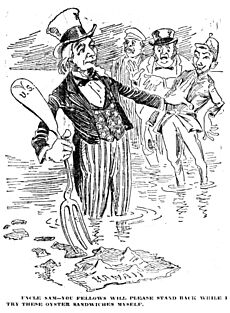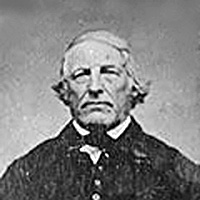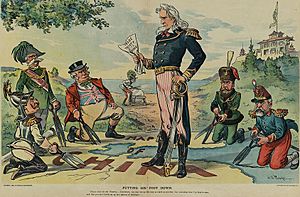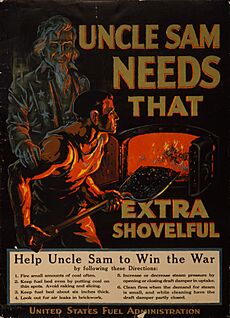Uncle Sam facts for kids
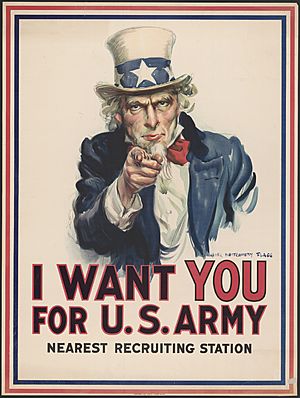
Uncle Sam is a well-known symbol of the United States government or the country itself. His initials, "U.S.", are the same as those for "United States". Since the early 1800s, Uncle Sam has been a popular sign of the U.S. government in American culture. He also shows patriotic feelings. Uncle Sam became very famous because of a 1917 World War I poster. This poster was used to get people to join the army.
People often say that the character of Uncle Sam started during the War of 1812. He might have been named after Samuel Wilson. However, his true beginning is not fully clear. The first time "Uncle Sam" was mentioned in a book was in 1816. The book was called The Adventures of Uncle Sam, in Search After His Lost Honor.
Uncle Sam mainly stands for the government. Another female character, Columbia, used to represent the United States as a nation. An older character, Brother Jonathan, was known to represent the American people.
Contents
Early American Symbols
The first known symbol for the United States was a woman named Columbia. She first appeared in 1738, before the U.S. was even a country. Sometimes she was linked with another female symbol, Lady Liberty.
When the American Revolutionary War started in 1775, a male symbol called Brother Jonathan appeared. Brother Jonathan became a full character representing the American spirit in a novel from 1825.
Uncle Sam finally showed up after the War of 1812. Columbia sometimes appeared with Brother Jonathan or Uncle Sam. But people used her less as a national symbol over time. She was mostly forgotten when she became the symbol for Columbia Pictures in the 1920s.
A journal entry from March 24, 1810, mentions "uncle Sam." It was written by Isaac Mayo, a sailor in the United States Navy. He wrote about being very seasick and joked that "uncle Sam" would lose his service.
How Uncle Sam Changed Over Time
An old newspaper from 1810 called Niles' Weekly Register said that "Uncle Sam" was a slang term in the army for the United States. It probably came from the letters "U.S." for "United States."
The Samuel Wilson Story
The exact start of the Uncle Sam character is not clear. But a popular story says the name "Uncle Sam" came from Samuel Wilson. He was a meat supplier from Troy, New York. He provided food for American soldiers during the War of 1812. Contractors had to stamp their name and where the food came from on the packages. Wilson's packages were marked "E.A.—U.S." When someone asked what "U.S." meant, a co-worker joked, "Elbert Anderson and Uncle Sam." They were referring to Wilson, even though "U.S." actually meant "United States."
Some people doubt this story. The claim did not appear in print until 1842. Also, the earliest known mention of the symbolic Uncle Sam is from 1810. This was before Wilson's contract with the government.
How the Character Developed
In 1835, Brother Jonathan mentioned Uncle Sam. This suggested they stood for different things. Brother Jonathan was the country itself. Uncle Sam was the government and its power.
By the 1850s, the names Brother Jonathan and Uncle Sam were used almost the same way. Pictures that used to be called "Brother Jonathan" were then called "Uncle Sam." Also, how both characters looked changed a lot. For example, one picture of Uncle Sam in 1860 looked like Benjamin Franklin. At the same time, a picture of Brother Jonathan looked more like the modern Uncle Sam, but without a goatee.
Uncle Sam did not have a standard look until the famous recruitment image was made by James Montgomery Flagg. This happened during World War I. The image was based on a British poster that showed Lord Kitchener in a similar pose. This image has shaped how Uncle Sam looks today. He is an older white man with white hair and a goatee. He wears a white top hat with white stars on a blue band, a blue tail coat, and red-and-white-striped pants.
Flagg's picture of Uncle Sam was first shown on the cover of Leslie's Weekly magazine on July 6, 1916. The caption asked, "What Are You Doing for Preparedness?" More than four million copies of this image were printed between 1917 and 1918. Flagg's image was also used a lot during World War II. During that war, the U.S. was secretly called "Samland" by a German spy agency. The song "The Yankee Doodle Boy" also featured the term. It was in the 1942 musical Yankee Doodle Dandy.
There are two memorials for Uncle Sam. Both honor the life of Samuel Wilson. One is the Uncle Sam Memorial Statue in Arlington, Massachusetts, where he was born. The other is near his home in Riverfront Park, Troy, New York. Samuel Wilson's childhood home can still be visited in Mason, New Hampshire. Samuel Wilson passed away on July 31, 1854, at 87 years old. He is buried in Oakwood Cemetery in Troy, New York.
In 1989, "Uncle Sam Day" became official. A special resolution in Congress made September 13, 1989, "Uncle Sam Day." This was Samuel Wilson's birthday.
See Also
 In Spanish: Tío Sam para niños
In Spanish: Tío Sam para niños
- Uncle Sam billboard
- Personification of the Americas
- Propaganda in the United States



